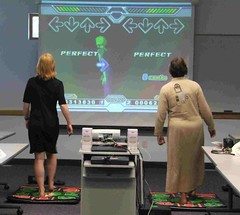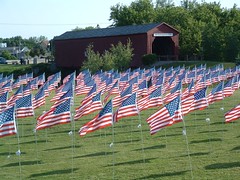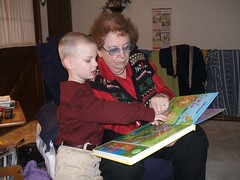Does appearance really matter? Or is it true what my mother used to tell me as an awkward adolescent that “it’s what’s inside that counts.” (sorry, Mom, it didn’t cut it then, and it doesn’t cut it now.) I lean more to the “what you see is what you get” idea.
I’ve been thinking a lot about image lately. Joyce Valenza admonished her listeners to model the “information professional” in her presentation at Computers in Libraries. And I think she meant in every way from actions to image. When I was training to be a customer service instructor for the squadron in my prior life as a civilian working for the military, I attended Fred Pryor customer service training. One thought stuck in my mind — impact is affected 83% by appearance and 17% by what is said. Watching the Today show this morning, one topic was body language – the guest said 90% of impression is made by what is observed.
While these statistics are pretty unscientific, I think they say something about the image we present both for ourselves as information professionals and also for the library institution. And I think that mantel is on us whether we’re punched in on company time, or buying a gallon of milk at the gas station. This reminds me of a friend who is a Mary Kay consultant, who says her training emphasizes to BE the Mary Kay product whenever and wherever she is — which includes dropping her kids off at school in the morning. My friends who are teachers are very cognizant of their image and actions in their communities. I think librarians who portray a professional demeanor (even in jeans at the garden shop – where I will be later today) will leave a lasting impression of someone worthy of trust to any citizen or board member they encounter.
I even bought a “Radical Militant Librarian” button a couple years ago, in a moment reminiscent of my college days. No, I didn’t wear the button, since that’s not the kind of sound-bite impression I want to make to the infinitely more people I encounter than will ever get to know me enough to understand what that pithy statement means. A librarian colleague has a T-shirt with an irreverent, though humorous, comment that uses a street word that I would not say in any customer or office communications. Would I wear it? No, because I can’t control the occurence of opportunistic moments that may make or break someone’s opinions and make lasting impacts on libraries or even my future career path.
Not too many years ago, businesses had strict dress codes, with the intent of modeling for the customers a professional image of their company. Gradually, about the time of the tech revolution, we saw an erosion of professional dress standards not only on blue-jeans Fridays but any time through the week. In recent years, many companies have returned to a dress code for employees. (although, I still struggle with what exactly “business casual” is — I think it might have something to do with the brand/price tag?) The fast food industry usually requires company-supplied shirts and uniform pants. Big box stores like Target require company-colored polo shirts. Even WalMart, in its marketing efforts to upgrade its image, is phasing in a uniform shirt for its employees.
And personal appearance is only one part of image. Other clues can send messages too. I was shocked at one management training class I attended that advocated a practice that the interviewer should walk the prospective employees back to their cars after interviews, assessing their vehicle condition, cleanliness, etc. as a point of character. And, from the employee side – someone I know who was interviewing with a certain company, arrived in town early and found the homes of management team members (using phone book addresses), looking for clues about their personal priorities.
All food for thought, I guess. And this leads to appearance of libraries – condition and decor . . . but that’s another blog post.






